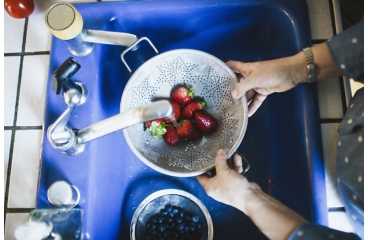Diabetic Renal Diet: Care Instructions
Overview

Your food choices are important when you have diabetes and kidney disease. Planning meals that have the right
amount of carbohydrate, protein, and other nutrients can help keep your blood sugar in your target range and
help your kidneys work as well as possible.
Your doctor and dietitian will help you make an eating plan. It will be based on your medical condition. For
example, you may need to limit salt, fluids, and protein. You also may need to limit minerals such as
potassium and phosphorus. It takes planning, but there are plenty of tasty, healthy foods you can eat. Always
talk with your doctor or dietitian before you make changes in your diet.
Follow-up care is a key part of your treatment and safety. Be sure to make and go to all
appointments, and call your doctor if you are having problems. It's also a good idea to know your test results
and keep a list of the medicines you take.
How can you care for yourself at home?
-
Work with your doctor or dietitian to create a food plan that guides your daily food choices.
-
Do not skip meals or go for many hours without eating.
-
Talk to your doctor or dietitian about ways to get more calories if you have a hard time eating enough.
-
If you would like to drink alcohol, ask your doctor if it's safe.
To get the right amount of protein
-
Ask your doctor or dietitian how much protein you can have each day. You need some protein to stay
healthy.
-
Include all sources of protein in your daily protein count. Besides meat, poultry, and fish, protein is
found in milk and milk products, beans, peas, lentils, nuts, seeds, tofu, and eggs. Check for protein on the
Nutrition Facts label found on packages of food such as bread and cereal.
To limit salt
-
Do not add salt to your food. And look for "low sodium" on labels.
-
Do not use a salt substitute or lite salt unless your doctor says it is okay. (These products are high in
potassium.)
-
Avoid or use very small amounts of condiments and marinades. These include soy sauce, fish sauce, and
barbecue sauce. They are high in sodium.
-
Avoid salted pretzels, chips, and other salted snacks.
-
Check food labels to become more aware of the sodium content of foods. Foods that are high in sodium
include soups; many canned foods; cured, smoked, or dried meats; and many packaged foods.
To control carbohydrate
To limit fluids
-
Know what your fluid allowance is. Fill a pitcher with that amount of water every day. If you drink
another fluid (such as coffee) that day, pour an equal amount out of the pitcher.
-
Foods that are liquid at room temperature count as fluids. These include ice, gelatin, ice pops, and ice
cream.
To limit potassium
-
Limit foods that are high in potassium. Potassium is in many foods, including vegetables, fruits, and milk
products. Some high-potassium foods are bananas, broccoli, cantaloupe, milk, oranges, potatoes, spinach, and
tomatoes.
-
Choose fruits and vegetables that don't have as much potassium. These include applesauce, blueberries,
cucumbers, grapes, green beans, lettuce, olives, pineapple, and raspberries.
To limit phosphorus
-
Follow your doctor's or dietitian's plan for your limit on milk and milk products in your diet.
-
Avoid nuts, peanut butter, seeds, lentils, beans, organ meats, and sardines.
-
Avoid cola drinks.
-
Avoid bran breads or bran cereals. They are high in phosphorus.
Current as of: September 20, 2023
Content Version: 14.0
Care instructions adapted under license by your
healthcare professional. If you have questions about a medical condition or this instruction, always ask
your healthcare professional. Healthwise, Incorporated disclaims any warranty or liability for your use of
this information.